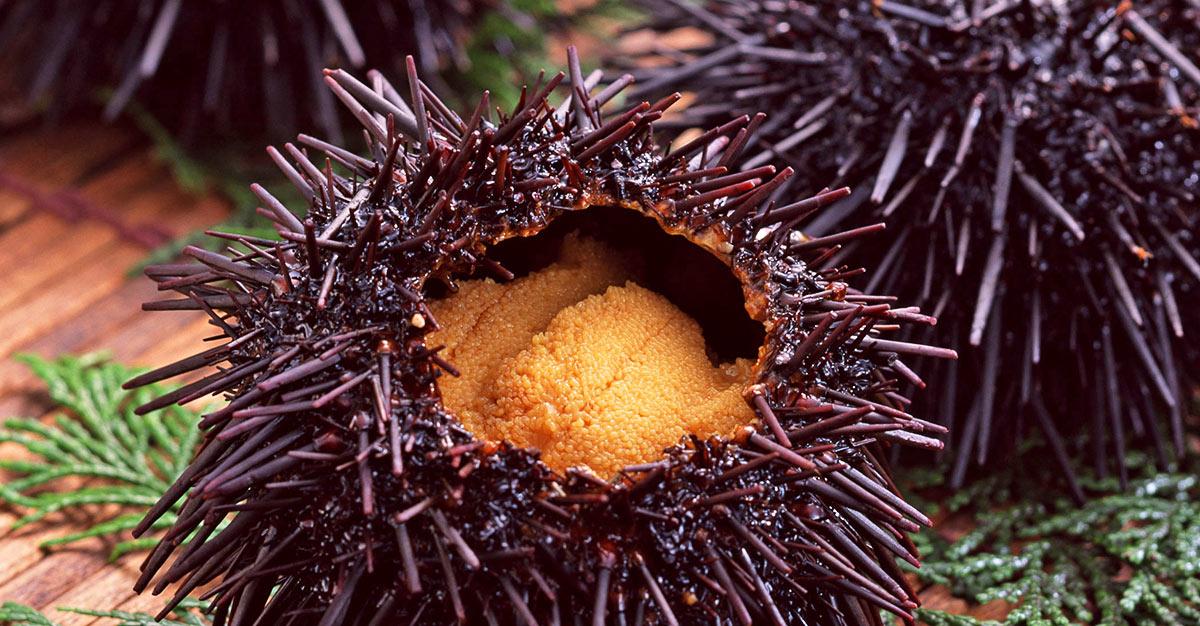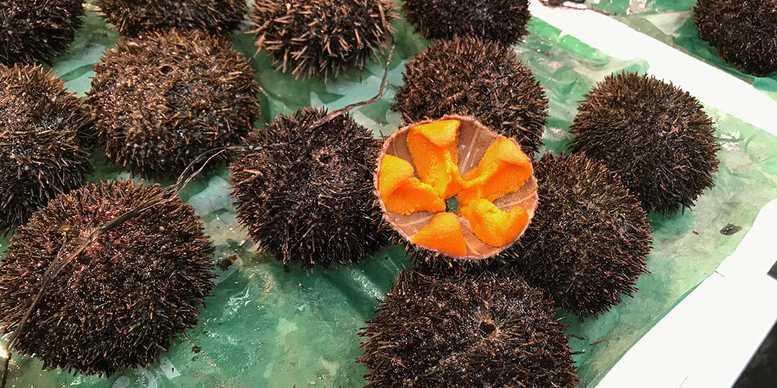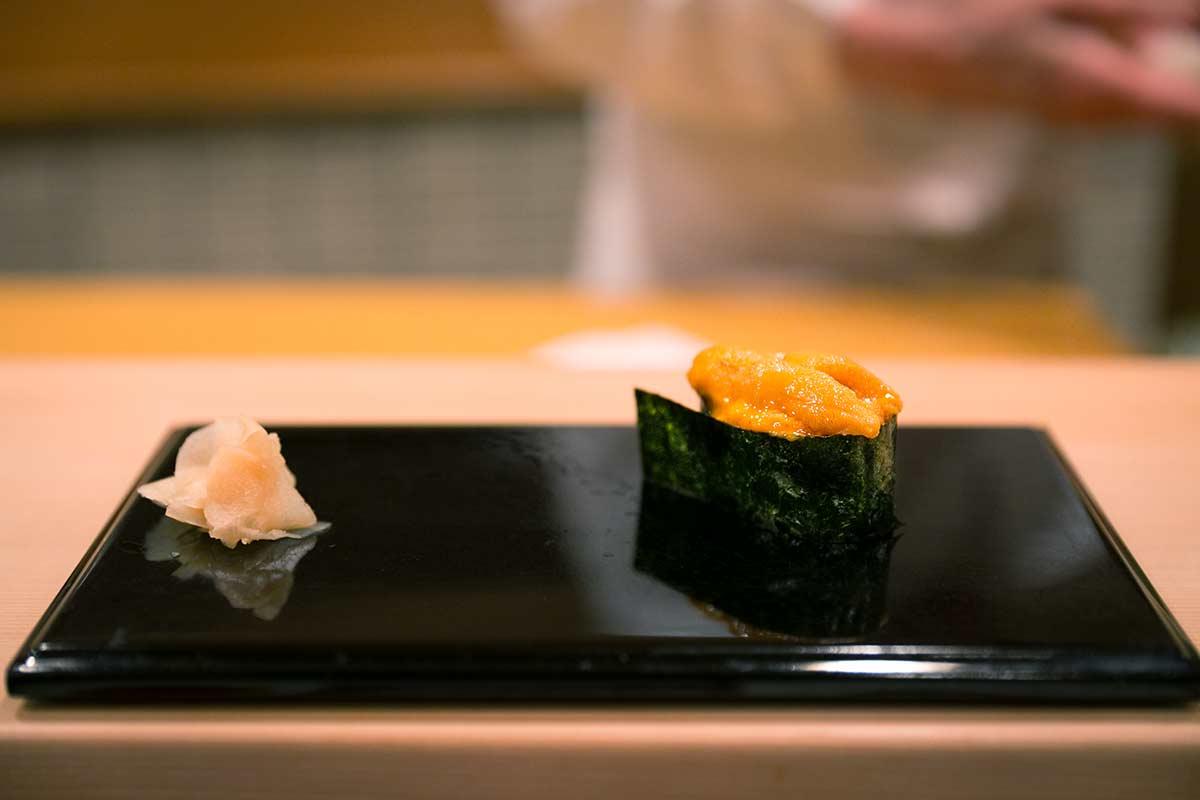Uni Sushi
Sea Urchin
What is Uni (Sea Urchin)?
Uni represents in Japanese the class of sea-urchins which belong to the Echinoderms. Worldwide there are up to a thousand species, but only a small part of them is valued as food. The gonads (reproductive glands of the uni, also occasionally referred to as roe, are considered a delicacy in Japan and many other regions of the world. Gonads are the sexual organs in which sex hormones and germ cells are produced. In a female animal these are the ovaries and in a male animal the testicles. The uni gonads are considered one of the most popular sushi ingredients in Japan.
Uni as Ingredient for Sushi or Sashimi

The raw gonads of the uni have an unmistakable taste. The exceptionally full-bodied umami taste is accompanied by mineral, sweet and slightly salty aromas reminiscent of the sea. The texture is extremely soft and literally melts on the tongue. Although uni can be eaten wonderfully on its own, it also tastes very well in combination with normal or vinegared rice. The most important factor for the good taste is freshness. Fresh uni has a pleasant and hardly noticeable odor. However, if stored too long or incorrectly, it has an unappetizing fishy smell and taste. For this reason, cheap, industrially processed or uni intended for export is enriched with alcohol or other preservatives (e.g. alum), which also have a negative effect on the taste. Another important factor is the nutrition of the sea urchins, as this influences the taste and the size of the gonads. Since the main component of their diet consists of seaweed, it is obvious that tasty sea urchins are mainly found in regions known for their seaweed quality [Takagi et al., 2017], [Takagi et al., 2020].
As Sushi, uni is prepared either as “battleship-roll” (gunkan-maki) or “hand-pressed” sushi (nigiri-zushi). Although it is a high-priced ingredient, it is today part of the standard repertoire in many sushi restaurants. The combination of uni and ika is popular, either as a side dish or by placing uni in small quantities on the ika meat. Ikura, the fish roe of the salmon, is also a popular side dish (e.g. uni ikura kaisen-don).
Best Season
The best season for sea urchins is very much dependent on the species and region. All species preferred in Japan vary so much throughout the year that uni can be eaten in good quality all year round. For example, ezobafununi is in season from spring to autum and kitamurasakiuni is in winter. Sea urchins caught on the coasts of Europe, the United States and Canada are particularly tasty during the winter months [Seafoodwatch, 2008]. Uni from sea urchins, which was fished out of season, is said to have a bitter and unappetizing taste.

Ensui Uni 塩水海胆
When uni are processed, they are usually broken open, cleaned and sorted before being arranged in the sales packaging. To increase shelf life, industrial preservatives are usually added to the extracted gonads. In ensui (えんすい) or shiomizu (しおみず) processing, on the other hand, the gonads are cleaned and then preserved in a salt solution. This salt water has approximately the same salinity as the sea water of the region from which the uni originate. It is said that this “natural” preservation method better preserves the original taste.
Uni in Japan
The characters 雲丹 (uni) are used to indicate the food produced from the gonads of the sea urchin. Translated, they are understood as “vermilion cloud” and describe as a metaphor the appearance of the food. The animal itself is described either with the signs 海胆, which can be interpreted as “innards of the sea”, or with 海栗, which can be translated as "sea chestnut" and indicates the external similarity.
The largest market for seafood and sea urchins is the toyosu-shijou market in Tokyo, nowhere else is uni traded on a comparable scale. Every day the daily price is determined at the uni auction (uni no seri). Besides tuna, uni is one of the few products whose price is still determined by auction nowadays. The auction is not a classical auction as it is usually known, in which the bidders bid in ascending order until no more bids are received, instead it is a variant in which each bidder makes only one bid. The contract is then granted to the bidder with the highest bid. The expected price ranges are wide, so uni in low quality is available from ¥400, while premium quality can reach 10,000 ¥ and more. As of January 16, 2020, ¥400 is equivalent to $3,85 and ¥10,000 is equivalent to $96,26. Uni is divided into three categories labeled A, B and C respectively. For the preparation of sushi only the top two levels A and B are used. A distinction is also made between color-coded and sorted uni (narabi) and various colored, unordered (bara) packages.
The most common types of sea urchins in Japan are the akauni (pink sea urchin), bafununi (green sea urchin), ezobafununi (ezo green sea urchin), kitamurasakiuni (Northern sea urchin), murasakiuni (purple sea urchin), and shirahigeuni (collector urchin) [Nishiki, 2022]. Kitamurasakiuni is the most commonly harvested edible sea urchin in Japan and accounts for about 44% of the total commercial harvest.
Characteristics & Ecology of Uni (Sea Urchin)
The spread-area stretches over all oceans and climatic zones, they populate rocky coasts as far as to the ground of the deep sea. Their food consists primarily of algae, but there are also species that feed on carrion, microorganisms or marine snow. Their natural predators are mainly sea otters and starfish. Some species of sea urchins are extraordinarily long-lived. Studies have shown that individuals of the red sea urchin can live up to 200 years [Ebert & Southon, 2003].
Most sea urchins traded on the Japanese market are ezobafununi and kitamurasakiuni. In Europe, the stone- and European edible sea urchin is the most common species. In the United States, sea urchins are most commonly served in Japanese sushi restaurants, where mainly purple-, red-, green sea urchins and species imported from Japan are used.
Ezobafununi

Ezobafununi belongs to the most fished sea urchin species in Japan. Ezo is an old Japanese term for the population in the east and north of Japan and refers to the area where ezobafununi has been fished since ancient times. In Japanese, bafun stands for the droppings of a horse and is a metaphor for the appearance of this sea urchin species. Even though they are not scientifically classified as belonging to the bafun genus (lat. Hemicentrotus), they are so visually similar that they traditionally bear their designation in their name. The Japanese distribution area stretches from Hokkaido to Sagami Bay. Import goods come mainly from South Korea and the adjacent coastal regions of Russia and China. The gonads have a visible orange coloration, the taste is full-bodied sweet and is highly appreciated in Japan as an ingredient for Sushi.
Kitamurasakiuni
The gonads of the kitamurasakiuni are visibly brighter than those of the ezobafununi, which is why they are also called “white sea urchin” in Japan (shirouni). The taste is light and has an elegant sweetness. The distribution area is similar to that of ezobafununi. Kitamurasakiuni caught on the coasts of Oma, in Aomori Prefecture, are considered a special delicacy in Japan and are traded at high prices.
Economy
The increased demand for sea urchins in recent decades has led to an expansion of fishing and overfishing of some species ([Botsford et. al., 2004], [Rogers-Benett, 2007]). Recently, the production of sea urchins in aquaculture has received more attention, especially as it allows to improve the growth and quality of the gonads [Lawrence et al., 2001].

Gallery


Further information on the author can be found in the section on image credits.
Video about Uni
External video embedded from youTube.com: SUSHI LABO. ウニ(バフンウニ)の握り【寿司の握り方】
Species of Uni
The following species are regarded as authentic. Either historically, according to the area of distribution or according to the common practice in today's gastronomy:
Japanese Name | Common Names, Scientific Name |
|---|---|
aka-uni アカウニ | pink sea urchin Pseudocentrotus depressus family: Strongylocentrotidae |
bafun-uni バフヌニ | Asian green sea urchin Hemicentrotus pulcherrimu family: Strongylocentrotidae |
ezo-bafun-uni エゾバフヌニ | Hokkaidō green sea urchin Strongylocentrotus intermedius family: Strongylocentrotidae |
hokuyouoo-bafun-uni ホクヨウオオバフヌニ | Northern green sea urchin Strongylocentrotus droebachiensis family: Strongylocentrotidae |
kita-murasaki-uni, shiro-uni キタムラサキウニ、シロウニ | Northern sea urchin Strongylocentrotus nudus family: Strongylocentrotidae |
maruhiuchidai マルヒウチダイ | Hoplostethus crassispinus family: Trachichthyidae |
murasaki-uni ムラサキウニ | purple sea urchin Heliocidaris crassispina family: Echinometridae |
shirahige-uni シラヒゲウニ | collector urchin Tripneustes gratilla family: Toxopneustidae |
The following species can be considered subsitutes. Either on the basis of genetic relationship or because they are similar in taste or appearance:
Japanese Name | Common Names, Scientific Name |
|---|---|
European edible sea urchin Echinus esculentus family: Echinidae | |
Atlantic purple sea urchin Paracentrotus lividus family: Parechinidae | |
amerika-murasaki-uni アメリカムラサキウニ | purple sea urchin Strongylocentrotus purpuratus family: Strongylocentrotidae |
amerika-oomurasaki-uni アメリカオオムラサキウニ | red sea urchin Mesocentrotus franciscanus family: Strongylocentrotidae |
References & Further Reading
- [Agatsuma, 2010]: Yukio Agatsuma. Ecology of Strongylocentrotus nudus. Developments in Aquaculture and Fisheries Science. Source.Volume 32. doi:10.1016/S0167-9309(01)80021-1.
- [Botsford et al., 2004]: Louis W. Botsford, Alan Campbell, Robert Miller. Biological reference points in the management of North American sea urchin fisheries. Canadian Journal of Fisheries and Aquatic Sciences. Source.Volume 61 (8). National Research Council of Canada, Ottawa. 2004.
- [Ebert & Southon, 2003]: Thomas A. Ebert, John R Southon. Red sea urchins (Strongylocentrotus franciscanus) can live over 100 years: confirmation with A-bomb 14carbon. Fishery Bulletin. Source.Volume 101 (4). National Oceanic and Atmospheric Administration, Washington. 2003.
- [Hashimoto & Telfer, 2008]: Atsuko Hashimoto, David J. Telfer. Food and Wine Festivals and Events Around the World, Ch: From saké to sea urchin: Food and drink festivals and regional identity in Japan. Routledge, London. 2008.
- [Lawrence et al., 2001]: John M. Lawrence, A.L. Lawrence, S.C. McBride, Sophie B George. Developments in the use of prepared feeds in sea-urchin aquaculture. World Aquaculture. World Aquaculture Society, Sorrento. 2001.
- [Lawrence, 2001]: John M. Lawrence. Edible Sea Urchins: Biology and Ecology, Sea Urchin Roe Cuisine, Developments in Aquaculture and Fisheries Science, Vol. 37. Elsevier Science, Amsterdam. 2001.
- [Nishiki, 2022]: 横浜・野毛の寿司屋 錦寿司 ≪ うにの豆知識 ≫ (engl. Nishiki-zushi, a sushi restaurant in Noge, Yokohama << Knowledge of sea urchin >>). 錦寿司. http://www.noge-sushi.com/okonomi/uni.html. Retrieved online on January 06, 2022.
- [Rogers-Benett, 2007]: Laura Rogers-Benett. Edible Sea Urchins: Biology and Ecology: The Ecology of Strongylocentrotus franciscanus and Strongylocentrotus purpuratus. Elsevier, Amsterdam. 2007.
- [Seafoodwatch, 2008]: Meredith Lopuch. Seafood Watch Seafood Report, Red Sea Urchin Strongylocentrotus franciscanus, Green Sea Urchin Strongylocentrotus droebachiensis. Monterey Bay Aquarium, Monterey. 2008. Retrieved online on December 27, 2020.
- [Tajimaa & Lawrence, 2001]: Kenichi Tajimaa, John M. Lawrence. Edible Sea Urchins: Biology and Ecology: Disease in edible sea urchins. Developments in Aquaculture and Fisheries Science. Source.Volume 32. Elsevier Science, Amsterdam. 2001.
- [Takagi et al., 2017]: Satomi Takagi, Yuko Murata, Eri Inomata, Hikaru Endo, Masakazu N. Aokia, Yukio Agatsuma. Improvement of gonad quality of the sea urchin Mesocentrotus nudus fed the kelp Saccharina japonica during offshore cage culture. Aquaculture. Source.Volume 477. Elsevier, Amsterdam. 2017.
- [Takagi et al., 2020]: Satomi Takagi, Yuko Murata, Eri Inomata, Masakazu N. Aoki, Yukio Agatsuma. Pronounced effects of the basal frond portion of the kelp Saccharina japonica on gonad qualities of the sea urchin Mesocentrotus nudus from a barren. Source.Volume 516. Elsevier, Amsterdam. 2020.
Image Credits
City Foodsters (Grace Chen, Jason Wang). Uni (sea urchin), Sukiyabashi Jiro, Tokyo, JP. flickr.com. License: Attribution 2.0 Generic (CC BY 2.0). Changes made: image quality, brightness, contrast, colour matching, sharpening, cropping.
Jun Seita. 雲丹 Fujifilm X-T1. flickr.com. License: Attribution 2.0 Generic (CC BY 2.0). Changes made: image quality, brightness, contrast, colour matching, sharpening, cropping.